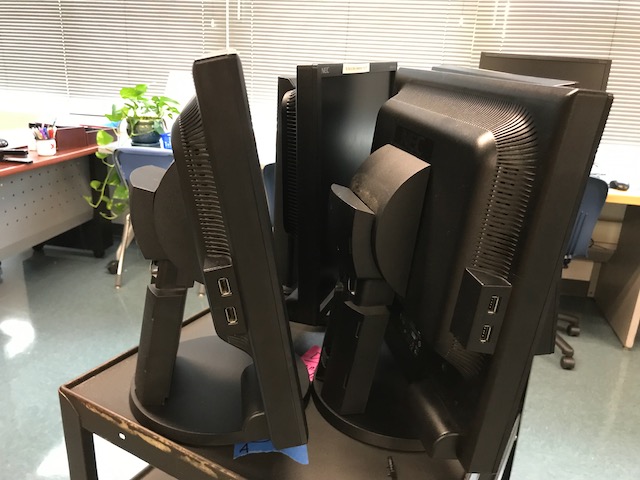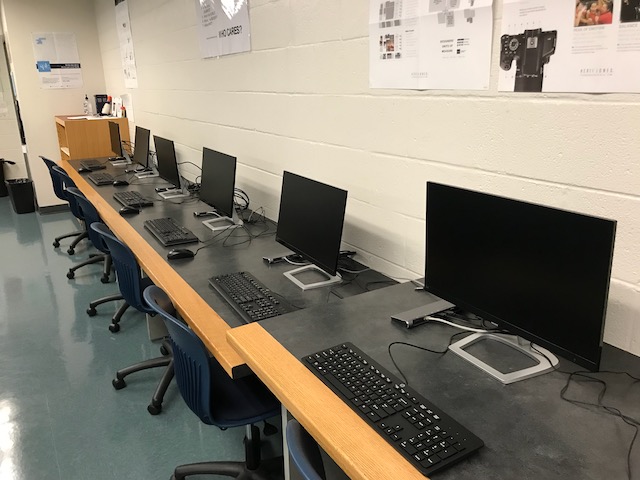The Background
I began my career as a journalism teacher just a few months shy of a decade ago. Upon entering the publications lab for the first time, I was greeted with a battery of about a dozen PCs running Windows XP. Already a few years old, these machines were…um…well, let’s call them “feisty.”
By my second or third year, it could take a good 15 minutes for a machine to boot up and finish loading InDesign. That was literally a third of the 45-minute newspaper class period I had that year.
Needless to say, investing in new computers was a priority for me. Thankfully, I’ve been fortunate to generate enough revenue each year from yearbook sales to be able to make some major tech purchases from time to time. The school also did its part to help us out. Within a few years, I had replaced all of the original machines and expanded our inventory to around 20 computers.
But as the 2018-2019 school year rolled around, a major change was in the air: the entire school system would be transitioning to a 1:1 technology initiative (i.e. a system where every student would be provided with a school-owned laptop). Under such a paradigm, the school district reasoned, there would be very little need for traditional computer labs or laptop carts.

Though I was reassured several times that the journalism lab would not be left out in the cold, I did worry for a few months that we would be stuck trying to run Adobe’s Creative Suite on the kind of low-end machines that would necessarily be purchased when supplying computers to thousands upon thousands of students.
The Problem
I was finally given an ultimatum around the last week of the school year: I could keep my 20 or so old machines if I really, really wanted to…or I could accept a set of 30 laptops just for the journalism lab that would be supplied by the school system at no cost to my program. I was assured that these were well-spec’d models purchased specifically for this use case.
I accepted the offer.
When I arrived at school at the beginning of this year, I was greeted by thirty 15-inch laptops with dedicated graphics cards, solid state drives, and and built-in full-sized keyboards. I was even given a set of brand new USB mice, one for each computer.
So to my relief, the school made good on its promise. But I still had a lingering discomfort. Much as these machines really impressed me, I still didn’t love the prospect of having my students spend hours and hours designing on laptops. Even at 15 inches, those screens are still fairly small for that kind of work. And if there’s one thing I know from running a computer lab for 10 years, it’s that if mice are being constantly unplugged and replugged every day, they will fall on the floor and shatter one by one or just mysteriously disappear.
In other words, much as I loved the laptops, my dream lab was still one populated by traditional desktop workstations.
The Objective
Thus was born my first major project of the school year: finding a way to reproduce the ergonomics and efficiency of our old setup while still taking advantage of our otherwise high-quality new hardware.
The Solution
Striking this balance was actually fairly straightforward. What we needed were a bunch of docking units that would allow us to convert the laptops into desktop-like workstations.
There are tons of docking stations out there. But because there were fairly modern laptops, I wanted something that would fully take advantage of their built-in technology. As it turned out, each of these PCs (Dell Latitude 5490s) had a single USB Type-C port. Dell advertised this primarily as a DisplayPort solution (in other words, as a port whose primary job was to hook up an external monitor). But after carefully examining the specs, I determined that these were in fact full-blown USB 3.1 interfaces that could be used with pretty much the whole range of USB 3.1-compatible devices.
This meant I could get a USB-C docking station that would basically replicate all the ports on a modern desktop computer: USB for keyboard and mouse, HDMI for the monitor, ethernet for network access, and then some. (This is one of the best things about USB 3.1 and USB Type C; there’s an adapter or dock out there for connecting just about anything!) What’s more: the ports on these Dell laptops even supported USB power delivery, meaning the right kind of dock could be used to charge the computers, too. (During a production week, we could be using a laptop for hours at a time, after all.)
There are a lot of docking stations out there at a wide range of prices. While I had some money to spend, this is still a school. We’ve still got to operate on a budget. So I ended up getting 16 of these generic docking stations from Amazon. I say “generic” because the brand doesn’t really seem to exist outside of Amazon.
At about $120, it’s a pretty good price for the variety fo ports that it offers, and we’re using nearly all of them: USB for mouse and keyboard; HDMI or DisplayPort for the monitor, ethernet, and a card reader, among others. The card reader is a great edition because we can use that for all our camera cards rather than wear out the laptop’s built-in reader!
I also purchased 16 Philips 226E9QDSB monitors, also from Amazon. At 22 inches, they’re significantly larger than the laptop screens, and at 1920×1080, they also offer higher resolution than the laptop screens. And all that for just $90 each!
The Outcome

So far, I’m satisfied with the purchase. I ran into a scare when I first started testing the equipment; I couldn’t get the docking stations to work with any of the existing monitors I had in the classroom. I tried DVI hookups, HDMI hookups, and all manner of adapter. But, as it turns out, the docks worked just fine with the brand new monitors, so it’s kind of a moot point.
The other disappointment is that the docking stations don’t come with their own power supply. And on top of that, you can only power them via USB-C. There are plenty of cheap generic USB-C power adapters on Amazon, but that’s one component that I will not trust from a no-name brand.
You don’t absolutely need a power supply, but my original goal was to be able to charge the laptops while they are in use. I will probably end up buying a USB-C power adapter directly from Dell just to play it safe. The one annoying thing is that for the price of the docking station plus the power adapters, I probably could have gotten a slightly less no-name-y model that had everything included. Lesson learned.
So far, my students seem to like the new setup. Only needing to plug one wire in is super-convenient. Though the viewing angle on the new monitors is only so-so, they are very sharp and bright to my eye. The kids need to remember to shut the laptop lid while it’s connected; otherwise, the monitors don’t always connect at the proper resolution.
Somewhat to my chagrin, many of the students are still just using the laptops on their regular desks because that’s just how they’re used to using laptops. I’m hopeful, however, that once we get into some serious design work in the next few weeks, they’ll find the larger screens and separate mice to be far more comfortable.